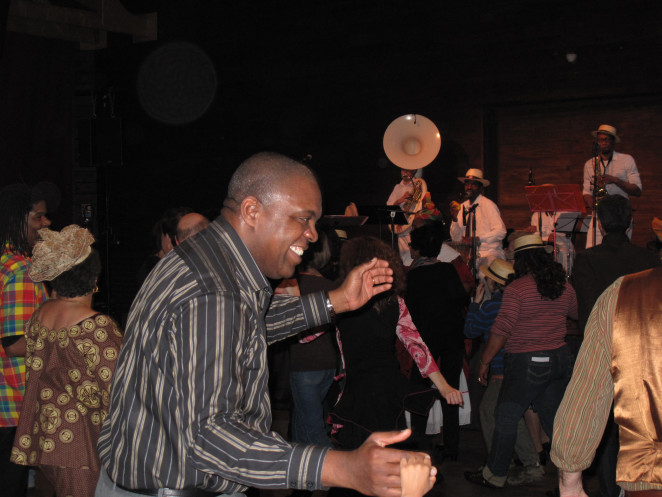
Quadrille music from Guadeloupe in the Banlieue of Paris
A square dance rages deep in the suburbs of Paris and a mixed crowd of French and West Indian locals shake their booties and toss partners to the sounds of funky mazurkas, quadrilles and waltzes.
“Dos-a-dos, promenade votre partenaire…” The dance calls and partner swinging might be familiar to your average American folk dancer, but this is no Appalachian square dance. We are at a “Creole Ball” and both the traditional music and dance – a heady mix of African rhythms and 19th century European dances known as Kwadril – come from the French West Indies.
On stage, the house band Caribop maintains a pulsating tropical dance groove with saxophone, accordion, tuba, tambour (long drum), triangle and other assorted percussion. At the same time, bandleader Marc alternates between explaining the dances, calling out the steps (assuming the role of a “caller” or commandeur) and playing saxophone and diatonic button accordion.
Caribop does the whole song and dance (literally) and it is testament to their dedication to playing and teaching the disappearing musical traditions of the overseas French “territories” of Guadeloupe and Martinique. Marc, like most of his band mates, was born in France but is of Afro-Caribbean origin. He is an ardent traditionalist, but with the younger generation of Guadeloupians and Martinicans both on the islands and in France losing interest in their musical traditions, Caribop has been reaching out to other folk music enthusiasts. As Paris has a vibrant folkdancing scene, Caribop has found some new fans of old-school Kwadril and Biguine.
This particular night, his biggest challenge: getting folk dancers, used to dancing “straight” dances à l’européen, to biguiner (swing) like it’s done in the French Caribbean. Just imagine shaking yer booty while doing a ballroom waltz. Not too easy, but it’s at the essence of French Caribbean music. Check out some footage:
The Traditional Quadrille Square Dances of the Caribbean
Behind the traditional dances of the French West Indies is a tangled transatlantic cultural conversation. Most North American musical forms have their origins in the marriage between African rhythms and European melodies – country music, blues, jazz, rock, etc. French Caribbean music is similar and the dance traditions reflect this.
Starting as early as the 16th century, the urban European upper classes began to adopt and “refine” wild rural peasant dances, such as the “country dance” (contredance). By the 18th century, these had evolved into new forms, such as the Quadrille or other “square” dances, which quickly became all the rage in ballrooms throughout Europe. These dances made their way – along with French colonists – to the plantations of the Caribbean. Lost yet? It gets more confusing.
Over time, the contredance and quadrille were “Creolized” by African slaves, who initially adopted the dances to mock their masters. After the abolition of slavery in 1848, Afro-Caribbeans took the dances and music to whole new levels, adding a bit of tropical sultriness into the genteel and courtly dance patterns. Quadrille became Kwadril, and other new Caribbean styles emerged out of European dance forms. Yet the dances still kept some of the aristocratic trappings from Europe – curtsies, bows etc.
Take the “Mazurka,” a popular 19th century ballroom dance that actually comes from an ecstatic triple meter dance form in Poland. Along with other courtly European dances, it was taken up and altered by Afro-Caribbeans. In Europe, it’s a stately waltz, while in the Caribbean it is at the essence of many musical forms. Marc breaks it down here how the triple meter Mazurka (a waltz in Europe) became a penultimate Caribbean groove:
For those familiar with modern Caribbean music, “zouk,” probably the most popular style in the West Indies, has its root in this dance. Mazurka became “mazouk” in Creole and was eventually shortened to “Zouk.”
